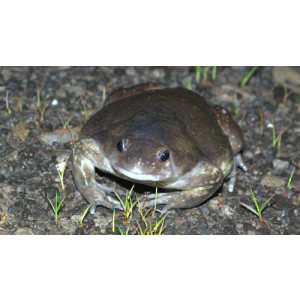Ornate Microhylid Frog Did you see this animal?
Scientific Name : Microhyla ornata
Family : Microhylidae
Order : Anura
Class : Amphibia
Phylum : Chordata
Other Name : Ornate Microhylid Frog
Habitat : Almost every type of habitat, except salt water.
Description : This species is found in a variety of habitats, including primary and secondary forests, agricultural areas, and disturbed habitats like rubber plantations and oil palm estates.
The Ornate Microhylid Frog is a small amphibian, with adults typically measuring between 2 and 3 centimeters in length. They have a plump body with short legs, and their skin is smooth and slimy. These frogs have large eyes, which helps them to see well at night.
These frogs are typically a bright green or yellow color, and they have intricate patterns and designs on their bodies. These patterns can include stripes, spots, and other shapes that help to camouflage the frog in its natural habitat.
the Ornate Microhylid Frog is nocturnal, which means that they are most active at night. During the day, they will hide in vegetation or under rocks to avoid predators. When they do move around, they move slowly and carefully, using their coloration to blend in with their surroundings.
This Frog is a carnivore, which means that it eats other animals. Their diet consists mainly of insects, such as ants, beetles, and crickets. They are also known to eat other small invertebrates, such as spiders.
These frogs breed during the rainy season, which usually occurs from May to October. Males will produce loud calls to attract females, and once a female is found, the male will cling to her back and fertilize her eggs as she lays them. The eggs are laid in moist soil or leaf litter, and they hatch into tadpoles, which then metamorphose into adult frogs.
It is not considered to be a threatened species at this time, but like many amphibians, they are susceptible to habitat loss and degradation. Deforestation and other human activities can have a negative impact on their populations, so conservation efforts are important to ensure that these unique frogs continue to thrive in the wild.
The Ornate Microhylid Frog is a small amphibian, with adults typically measuring between 2 and 3 centimeters in length. They have a plump body with short legs, and their skin is smooth and slimy. These frogs have large eyes, which helps them to see well at night.
These frogs are typically a bright green or yellow color, and they have intricate patterns and designs on their bodies. These patterns can include stripes, spots, and other shapes that help to camouflage the frog in its natural habitat.
the Ornate Microhylid Frog is nocturnal, which means that they are most active at night. During the day, they will hide in vegetation or under rocks to avoid predators. When they do move around, they move slowly and carefully, using their coloration to blend in with their surroundings.
This Frog is a carnivore, which means that it eats other animals. Their diet consists mainly of insects, such as ants, beetles, and crickets. They are also known to eat other small invertebrates, such as spiders.
These frogs breed during the rainy season, which usually occurs from May to October. Males will produce loud calls to attract females, and once a female is found, the male will cling to her back and fertilize her eggs as she lays them. The eggs are laid in moist soil or leaf litter, and they hatch into tadpoles, which then metamorphose into adult frogs.
It is not considered to be a threatened species at this time, but like many amphibians, they are susceptible to habitat loss and degradation. Deforestation and other human activities can have a negative impact on their populations, so conservation efforts are important to ensure that these unique frogs continue to thrive in the wild.
Distribution in Bangladesh
References:
description written by: Md. Shalauddin, Department of Zoology, Jagannath University, Dhaka. Information sources: IUCN Red List Bangladesh-2015, Hasan 2014, Khan 2018 (Photographic guide to the wildlife of Bangladesh).photo credit:viraljoshi(www.inaturalist.org/people/viraljoshi),photo copyright: iNaturalist. more information please contact with us.
description written by: Md. Shalauddin, Department of Zoology, Jagannath University, Dhaka. Information sources: IUCN Red List Bangladesh-2015, Hasan 2014, Khan 2018 (Photographic guide to the wildlife of Bangladesh).photo credit:viraljoshi(www.inaturalist.org/people/viraljoshi),photo copyright: iNaturalist. more information please contact with us.



















